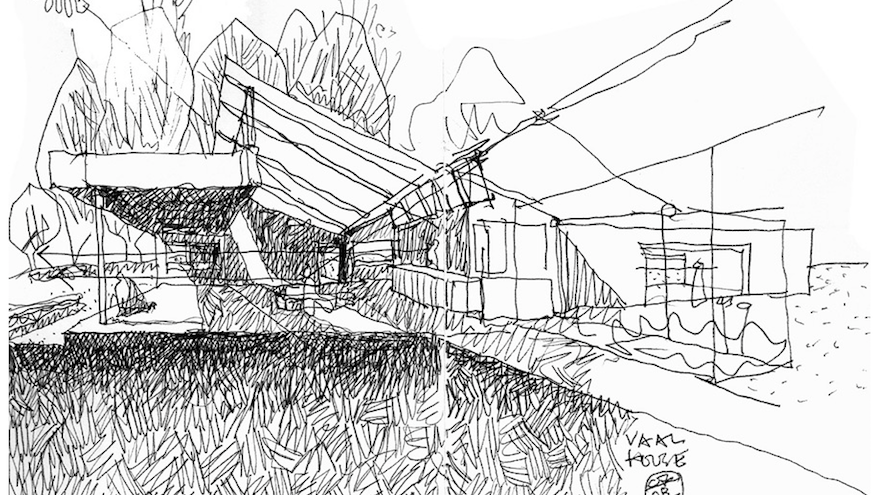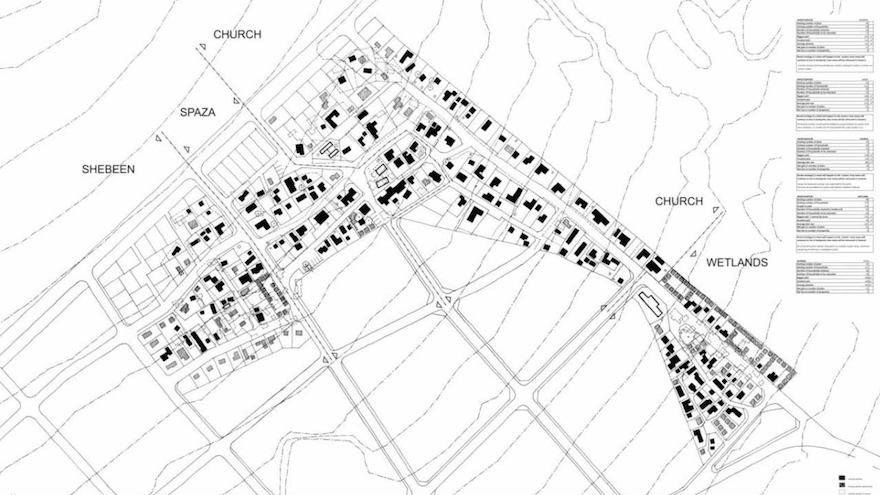26’10 South Architects was established by Thorsten Deckler and Anne Graupner in 2004. In the 10 years they have been working, the practice has undertaken projects in townships, the suburbs, inner city Johannesburg and its edges. The studio combines the disciplines of architecture, urban design and knowledge management.
Both Deckler and Graupner have studied and worked overseas – Deckler in the Netherlands and Graupner in Austria – but both felt drawn back to South Africa. The name of their award-winning studio – “26’10” – comes from the latitude line that Johannesburg sits on and is an acknowledgement of the way they choose to interact with the vibrant and paradoxical city they live in. Johannesburg, to this architect pair, represents many of the contrasts in South Africa: the malls, the spazas, the shacks and the gated multimillion rand properties.
The couple built their studio/home, a space designed to have flexible living and working areas, in an old working class suburb in central Johannesburg in a building that was once a corner shop and then a cooking school.
26’10 has been involved in a number of projects that aim to address the issues around housing settlements. In 2008 they collaborated with the Goethe-Institut on a research project, “Housing and the Informal City”, that investigated informal housing processes using Diepsloot – a township 40km north of the Johannesburg city centre – as a case study.
26’10 believe in the importance of working with the community on projects. The architects looked at the choices residents of Diepsloot were making for their own housing and, instead of applying a set of new rules, they conceived ways to use existing practices to upgrade current informal settlements to allow for better quality of life and more available housing.
The practice of “in-situ upgrading” of housing is already being used by the Department of Human Settlements as an alternative to building houses from scratch, and the 26’10 architects believe it is more effective in many cases. The project in Diepsloot developed into a masters programme called Informal Studio for the architecture school of the University of Johannesburg.
We chatted to Thorsten Deckler about the problems with architecture courses at South African universities, the rooftop bath atop his studio/home, and how well informed architectural design can be used to alleviate pressure on housing and change the emotional, as well as the actual, landscape of a place.
The name "26’10" comes from the geographical position of Johannesburg. How much do you think a place defines its people?
Living and working in a place like Johannesburg invariably impacts on one’s psyche. It means being constantly aware or reminded of the historical, physical and psychological barriers of the city and how these impact on people’s lives, their interactions and the choices they make. As an architect I don’t want to mindlessly flesh out this physical template nor be too beholden to its commercial interests. I see it as my responsibility to work on either side of the privilege spectrum. Whilst these are all very personal decisions, they are strongly informed by growing up under and benefitting from Apartheid as well as being part of the democratic transition. One particular trait that I imagine comes out of these experiences is that I am quite allergic to one absolute truth. I think this is simply not a position suited to the multiple South African realities that need to somehow coexist and thrive.
How can architecture enable people to redefine themselves?
Architecture can constrain and dominate, but can also enable life to unfold. To achieve the latter, architecture needs to operate on multiple levels, be open to interpretation, allow human interaction and be able to grow and change. This is particularly important when it comes to housing. A 40m2 subsidised house can simply not be understood as a timeless piece of architecture but should be seen as a "starter pack" which allows owners to add rental rooms, a shop, a first floor, a garage, etc.
Can architects be broad in their scope, or would they be better equipped to focus on a local area?
Over the past 10 years, our output has included the editing of a book, curating several exhibitions, producing artwork, films and events, teaching and writing, interiors and furniture, private and public buildings, infrastructure and the planning of an entirely new neighborhood of 20 000 houses – all within one hour’s drive of our office! Working in a city that contains such diverse cultures and landscapes has allowed us to broaden our scope of architecture without losing the focus on local conditions.
How does engaging with a community before and during design work affect a project?
In the traditional procurement of projects, engaging with communities is often limited and one has to be extremely observant and open in order to develop appropriate design responses. In the cases where we have had a lot of interaction with people, the results are always unexpected. Both architect and client need to work through all the assumptions and parameters of a project in order to find a workable solution.
In the case of informal settlement upgrading, this engagement is central to the process and can re-define the priorities of spending and investment in an area.
When did you build your studio/home? What particular quirks in its design are you most proud of?
We built the studio/home in 2012. Re-purposing existing timber shutters, sash windows, plumbing and light fittings saved us money but also added an unexpected layer to the house which tells a story of what was there before. The bathtub on the roof (also a recycled fitting) is actually our en-suite bathroom! It helps us unwind and the kids enjoy being able to splash as much as they want. It adds a kind of holiday atmosphere to our work and home life.
One of your biggest concerns is architecture schools not adequately teaching South African students. How could this be changed?
Medical schools have long recognised that practical experience for both staff and students is critical in qualifying doctors who are conscious of and able to practice in local conditions. Long-term working partnerships exist between universities and state departments where learning happens in the field, generating research and offering treatment to patients. I believe it might do architecture schools good to engage in similar partnerships with the public sector. An example from Brazil is the Escola da Cidade, a private architecture school run by practising architects that takes on private and public commissions. I’m not talking about 1:1 design and build studios parachuting into poorer communities. This school grapples with commissions that need to balance urban, economic and social needs of a tough megacity. Graduates qualify with a degree in urban design, architecture and landscape architecture to boot!
With the above in mind, SA schools have some way to go. As an architect having to employ and (re)train graduates, I also think that a dialogue between the profession and academia could be fruitful. I get a bit concerned by some schools implying that housing is too complex an issue for students to tackle or discourage their charges from designing commercial buildings.
How do real life projects and case studies enhance a curriculum?
They add nuance and depth to designers’ understanding of context as well as the humility that design divorced from the technical, economic, social and political context will only ever generate a pretty picture which will not stand up to scrutiny nor will it be implementable. What are we training architects for if not to impact on the pressing challenges we face?
What is unique about “in-situ upgrading” of housing and how do you think it can be more effective than building from scratch?
It is simply too expensive and slow to roll out subsidised housing for all. There’s a 2.3 million backlog. Even if we go for it, not every household would qualify as a beneficiary. The private sector cannot provide affordable housing to all non-qualifiers or the entire gap market since the affordability is too low. The homes (shacks) people have constructed as a result are therefore here to stay. The eradication of settlements is not feasible if no alternative accommodation can be provided. Incrementally upgrading well-located settlements by providing infrastructure, services and tenure is thus another way of providing housing.
When it comes to incremental upgrading, there’s nothing new or unique about it. People have been doing it themselves forever. They add to cities, villages, homes, re-decorate and extend over time as resources become available. What is unique is that, in the case of South Africa, upgrading of informal settlements is being recognised as a major secondary form of housing delivery.
The project in Malboro South (part of the Informal Studio course) was exhibited in 2014. Have any of the students' suggestions been taken further or been acted on? The exhibition must have got some attention, one might imagine – from whom and to what effect?
Students’ design concepts were not the central output of this course. Our agreement with the NGO and community was to prepare a mapping of the actual land-uses, illegal and legal, which have established themselves over the past two decades in the area. These have transformed an industrial buffer into a "city" with various functions ranging from housing to trading, worshipping to leisure. The mapping for which the students generated the base data helped establish a clearer picture of life in Marlboro South and informed planners, architects, politicians and people at the other end of the privilege spectrum to recognise the reality of life here. Whilst the exhibition received a lot of international and local attention, we were most proud of the fact that the content of the exhibition landed up in the South African Presidency and, as a result, the City’s Housing Department has been given a direct mandate to engage with the communities residing in Marlboro South.
Are you very select about the jobs you take on? Do you accept many private or high-end commissions?
We enjoy working on a range of projects and will take on private sector commissions if we feel there is a synergy between us and the clients or developer. In fact, I would love to be able to do a high-income residential project based on a courtyard typology which would be much more efficient in its land utilisation. We are most passionate about public projects, be they infrastructure, public buildings or housing.
How do you begin to break down the divides in the bricks and mortar of a city?
Transport and land-use is key, but so are competent and approachable public servants and empathetic professionals. Establishing working partnerships with communities, the public and private sector is key in addressing some of the really tough and complex urban challenges. Design professionals will not solve these on their own and need to be comfortable in creating and facilitating processes rather than only focusing on a built end result.
In the 10 years of 26’10's operation, what particular projects challenged you and had a lasting effect on the way you work?
Our first commission (with Lindsay Bremner) was for the re-building of the historic Sans Souci Cinema in Soweto. With a tiny budget we opted to realise the content rather than the container. After producing a design that could be implemented in phases, we started by arranging events that would most likely occur there. In the end the cinema was not rebuilt as the city was pouring its resources into the Kliptown Square as a "catalytic" project that has unfortunately not delivered on its promise of economic stimulation.
This experience has taught us that buildings can become liabilities if not conceived, owned and managed properly. We are quiet skeptical of the claims architects and awards make on behalf of buildings. We often incorporate a research component into our design process in order to better understand the context and type of commissions we work on. This has motivated us on a five-year research project on housing and informal urbanism and helped us better understand the field of subsidised housing, settlement upgrading and the gap market.










